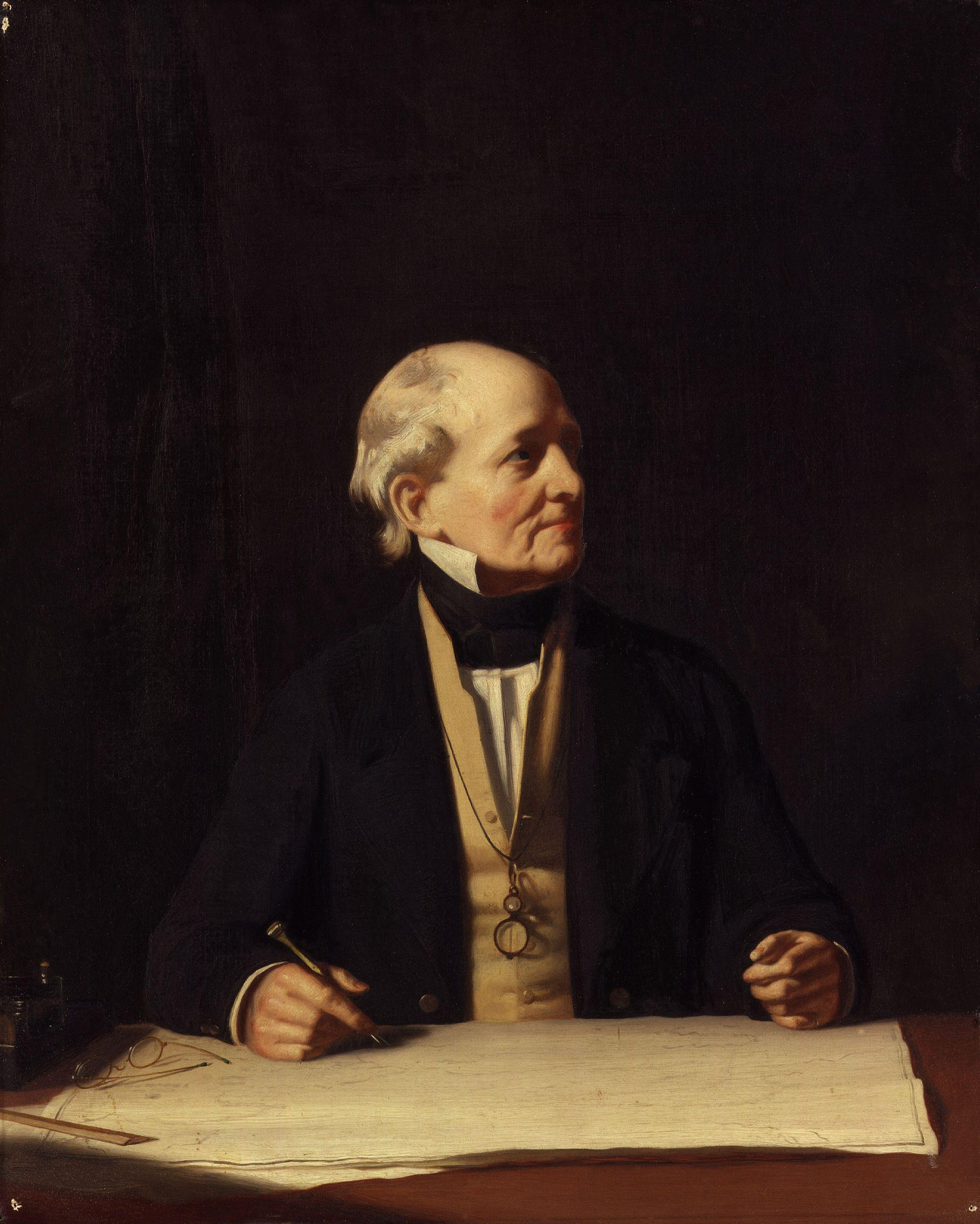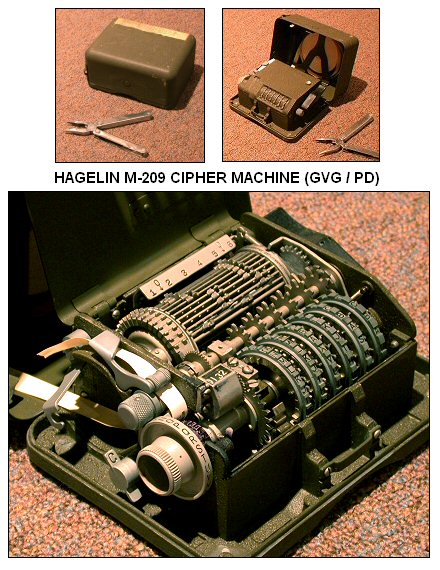Rear admiral Sir Francis Beaufort was an Irish hydrographer and officer in the Royal Navy who became famous for the wind force scale named after him: the Beaufort Scale. Like other patrons of exploration, he also had his name given to geographical places, including the Beaufort Sea and Beaufort Island.


Perhaps less known is the Beaufort cipher: a cipher he invented for encoding and decoding messages. Its most famous application was in a rotor-based cipher machine used in World War II: the Hagelin M-209. In the Beaufort cipher, each letter (A–Z) has a value (0–25) that corresponds to its position in the alphabet.

To encode a message $$M = M_0\ldots M_{n-1}$$ of $$n$$ letters, the Beaufort cipher uses a keyword whose letters are repeated or truncated to obtain a second sequence $$K = K_0\ldots K_{n-1}$$ of $$n$$ letters. The ciphertext $$C = C_0\ldots C_{n-1}$$ (the encoded message) of $$n$$ letters is obtained by subtracting (the values of) the letters at corresponding positions (modulo 26): \[ C_i = (K_i - M_i)\ \textrm{mod}\ 26 \ \ \ i = 0, \ldots, n-1\] If we apply this to encode the message DEFENDTHEEASTWALLOFTHECASTLE with keyword FORTIFICATION, we get

A ciphertext can be decoded by encoding it using the same procedure. After all, it applies that \[ M_i = (K_i - C_i)\ \textrm{mod}\ 26 \ \ \ i = 0, \ldots, n-1\] If we apply this to the above example, we get

Because decoding with a Beaufort cipher uses the same procedure as encoding, it is called a symmetrical cipher.
Assignment
Define a class Beaufort that can be used for encoding and decoding messages with a Beaufort cipher that uses a keyword $$K$$ that is passed when creating objects of the class. The class may assume that all messages, keywords and ciphertexts only contain uppercase letters and that keywords have at least four letters, without the need to check this explicitly. In addition, a Beaufort cipher (Beaufort) must support at least the following methods:
-
A method encode_letter that takes two arguments: i) the $$i$$-the letter $$M_i$$ (str) of a message and ii) the position $$i$$ (int) of that letter in the message, where zero-based indexing is used for the positions. The method must return the $$i$$-th letter $$C_i$$ in the corresponding ciphertext.
-
A method encode that takes a message $$M$$ (str) and returns its corresponding ciphertext $$C$$ (str).
-
A method decode_letter that takes two arguments: i) the $$i$$-the letter $$C_i$$ (str) of a ciphertext and ii) the position $$i$$ (int) of that letter in the ciphertext, where zero-based indexing is used for the positions. The method must return the $$i$$-th letter $$M_i$$ in the original message.
-
A method decode that takes a ciphertext $$C$$ (str) and returns the original message $$M$$ (str).
If a Beaufort cipher (Beaufort) is passed to the built-in function str, its keyword (str) must be returned with all but the first two and the last two letters replaced by asterisks (*). Similarly, the built-in function repr must return a string (str) whose format can be derived from the example below.
The addition (+) of two Beaufort ciphers (Beaufort) with keywords $$r = r_0\ldots r_{a-1}$$ and $$s = s_0\ldots s_{b-1}$$ must yield a new Beaufort cipher (Beaufort) with keyword $$t^{+} = t^{+}_0\ldots t^{+}_{c-1}$$. With $$c$$ being the least common multiple of $$a$$ and $$b$$, we can determine $$r' = r'_0\ldots r'_{c-1}$$ as $$\frac{c}{a}$$ repetitions of $$r$$ and $$s' = s'_0\ldots s'_{c-1}$$ as $$\frac{c}{b}$$ repetitions of $$s$$. The keyword $$t^{+}$$ is obtained by adding (the value of) the letters at corresponding positions (modulo 26): \[ t^{+}_i = (r'_i + s'_i)\ \textrm{mod}\ 26 \ \ \ i = 0, \ldots, c-1\] If we apply this to the keywords SECRET and WORD, we get

Least common multiple
For the least common multiple $$\textrm{lcm}(a,b)$$ of two natural numbers $$a$$ and $$b$$ it holds that \[ \textrm{lcm}(a,b) = \frac{a \times b}{\textrm{gcd}(a, b)} \] where $$\textrm{gcd}(a, b)$$ is the greatest common divisor of $$a$$ and $$b$$. In Python, the latter can be determined using the gcd function from the math-module of The Python Standard Library.
Similarly, the subtraction (-) of two Beaufort ciphers (Beaufort) must yield a new Beaufort cipher (Beaufort) with a keyword $$t^{-} = t^{-}_0\ldots t^{-}_{c-1}$$ that is obtained by subtracting (the value of) the letters at corresponding positions (modulo 26): \[ t^{-}_i = (r'_i - s'_i)\ \textrm{mod}\ 26 \ \ \ i = 0, \ldots, c-1\] If we apply this to the keywords SECRET and WORD, we get

The multiplication (*) of an integer $$k$$ (int) with a Beaufort cipher (Beaufort) with keyword $$r = r_0\ldots r_{a-1}$$ — or vice versa — must yield a new Beaufort cipher (Beaufort) with a keyword $$t^{*} = t^{*}_0\ldots t^{*}_{a-1}$$ that is obtained by multiplying (the value of) all letters with $$k$$ (modulo 26): \[ t^{*}_i = k\,r_i\ \textrm{mod}\ 26 \ \ \ i = 0, \ldots, a-1\].
Example
>>> cipher = Beaufort('FORTIFICATION')
>>> print(cipher)
FO*********ON
>>> cipher
Beaufort('FORTIFICATION')
>>> cipher.encode_letter('D', 0)
'C'
>>> cipher.encode_letter('E', 1)
'K'
>>> cipher.encode_letter('F', 2)
'M'
>>> cipher.encode('DEFENDTHEEASTWALLOFTHECASTLE')
'CKMPVCPVWPIWUJOGIUAPVWRIWUUK'
>>> cipher.decode_letter('C', 0)
'D'
>>> cipher.decode_letter('K', 1)
'E'
>>> cipher.decode_letter('M', 2)
'F'
>>> cipher.decode('CKMPVCPVWPIWUJOGIUAPVWRIWUUK')
'DEFENDTHEEASTWALLOFTHECASTLE'
>>> Beaufort('SECRET') + Beaufort('WORD')
Beaufort('OSTUAHJHYFVW')
>>> Beaufort('SECRET') - Beaufort('WORD')
Beaufort('WQLOIFBBGDNQ')
>>> Beaufort('SECRET') * 3
Beaufort('CMGZMF')
>>> 3 * Beaufort('SECRET')
Beaufort('CMGZMF')
>>> Beaufort('SECRET') + Beaufort('SECRET') + Beaufort('SECRET')
Beaufort('CMGZMF')
Epiloog: Action!

Don Martin’s cartoons in MAD magazine were famous for their sound effects:
- ARGLE GLARGLE GLORGLE GLUK: princess using mouthwash
- BUKKIDA BUKKIDA BAKKIDA BAKKIDA: boxer pummeling opponent’s head
- CHOOK CHOOK CHOOK CHOOK: man digging
- DOOT: doctor hitting patient’s knee with a hammer
- FAGWOOSH SHOSSH GOOGLOOOM FUSH: sounds heard in a seashell
- FLOOT THWIP THOP KLOP: a man folds up a beach umbrella
- FOOWOOM: flamethrower
- FWISK FWISK FWISKITTY FWASK: man sweeping a desert island
- GEEEN: Plastic Man giving the finger to a guy on the 32nd floor
- KITTOONG SHKLUNK: brain thrown into Frankenstein’s head like a basketball
- KOONG: man hit in head with wheelbarrow full of cement
- MOWM: atomic blast
- POING POING POING: pogo stick
- SHKWITZ SHKWITZ: man cleaning eyeglasses
- SLOOPLE GLIK SPLORP: man eating soup
- WUNK SPWAPPO KATOONK SPLAT: passengers attacking a hijacker
Doug Gilford maintains an online database.